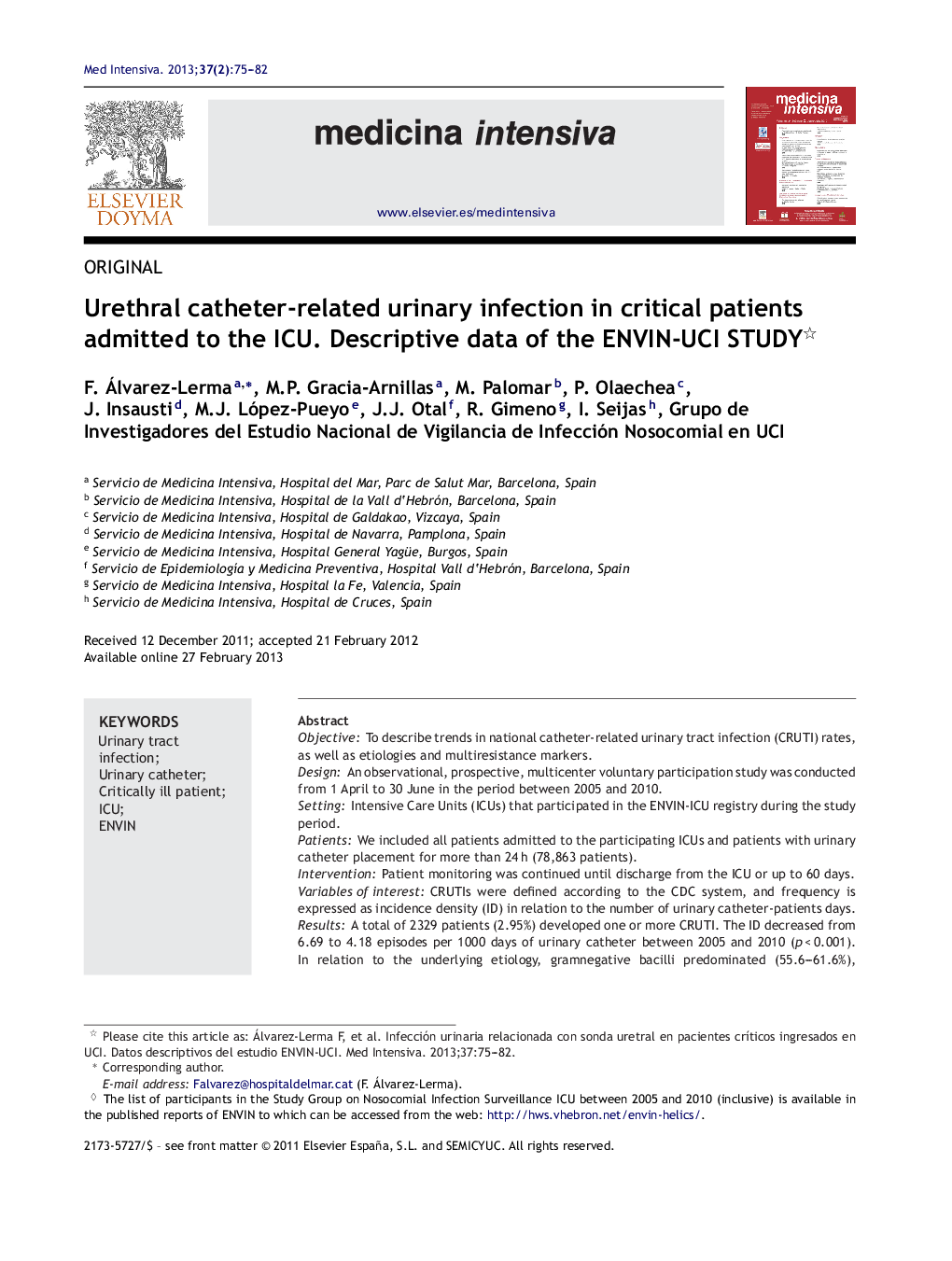| Article ID | Journal | Published Year | Pages | File Type |
|---|---|---|---|---|
| 3114247 | Medicina Intensiva (English Edition) | 2013 | 8 Pages |
ObjectiveTo describe trends in national catheter-related urinary tract infection (CRUTI) rates, as well as etiologies and multiresistance markers.DesignAn observational, prospective, multicenter voluntary participation study was conducted from 1 April to 30 June in the period between 2005 and 2010.SettingIntensive Care Units (ICUs) that participated in the ENVIN-ICU registry during the study period.PatientsWe included all patients admitted to the participating ICUs and patients with urinary catheter placement for more than 24 h (78,863 patients).InterventionPatient monitoring was continued until discharge from the ICU or up to 60 days.Variables of interestCRUTIs were defined according to the CDC system, and frequency is expressed as incidence density (ID) in relation to the number of urinary catheter-patients days.ResultsA total of 2329 patients (2.95%) developed one or more CRUTI. The ID decreased from 6.69 to 4.18 episodes per 1000 days of urinary catheter between 2005 and 2010 (p < 0.001). In relation to the underlying etiology, gramnegative bacilli predominated (55.6–61.6%), followed by fungi (18.7–25.2%) and grampositive cocci (17.1–25.9%). In 2010, ciprofloxacin-resistant Escherichia coli strains (37.1%) increased, as well as imipenem-resistant (36.4%) and ciprofloxacin-resistant (37.1%) strains of Pseudomonas aeruginosa.ConclusionsA decrease was observed in CRUTI rates, maintaining the same etiological distribution and showing increased resistances in gramnegative pathogens, especially E. coli and P. aeruginosa.
ResumenObjetivoDescribir la evolución de las tasas nacionales de las infecciones urinarias relacionada con sonda uretral (IU-SU), así como la de sus etiologías y marcadores de multirresistencia.DiseñoEstudio observacional, prospectivo, de participación voluntaria y multicéntrico desde el 1 de abril al 30 de junio entre los años 2005 y 2010.ÁmbitoUnidades de Cuidados Intensivos (UCI) que participaron en el registro ENVIN-UCI en el periodo de estudio.PacientesSe han incluido todos los pacientes ingresados en las UCI participantes y portadores de sonda urinaria durante más de 24 horas (78.863 pacientes).IntervenciónLa vigilancia de los pacientes ha sido continua hasta el alta de UCI o un máximo de 60 días.Variables de interésSe han definido las IU-SU siguiendo los criterios del CDC y su frecuencia se expresa como densidad de incidencia (DI) en relación al número de días de paciente-SU.ResultadosHan presentado una o más IU-SU 2.329 (2,95%) pacientes. La DI de IU-SU ha disminuido desde 6,69 a 4,18 episodios por 1.000 días de SU desde el año 2005 al año 2010 (p < 0,001). En la etiología han predominado los bacilos gramnegativos (55,6-61,6%), seguido de hongos (18,7-25,2) y de los cocos grampositivos (17,1-25,9%). En el año 2010, han aumentado las cepas de E. coli resistentes a ciprofloxacino (37,1%) y de P. aeruginosa resistente a imipenem (36,4%) y ciprofloxacino (37,1%).ConclusionesDisminución de las tasas de IU-SU, manteniéndose la misma distribución de etiología e incrementándose las resistencia en los BGN, en especial el Escherichia coli y Pseudomonas aeruginosa.
